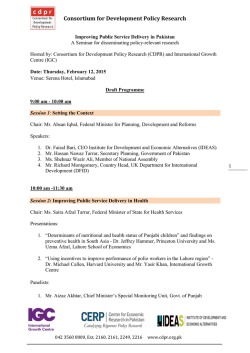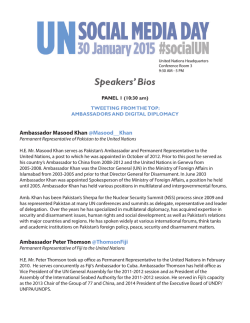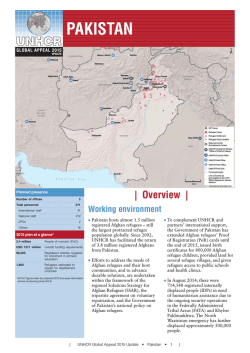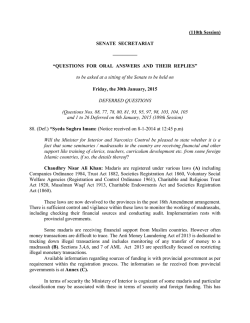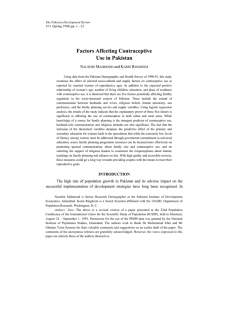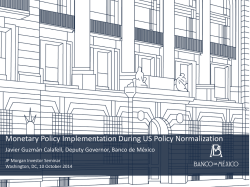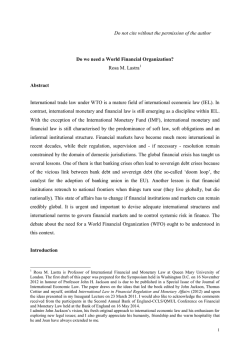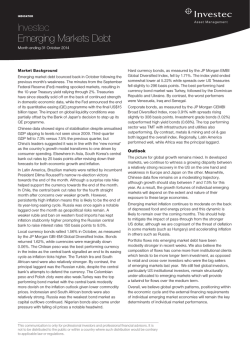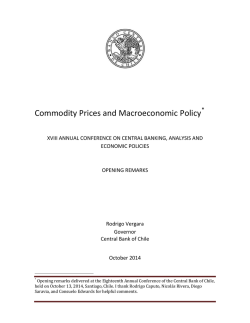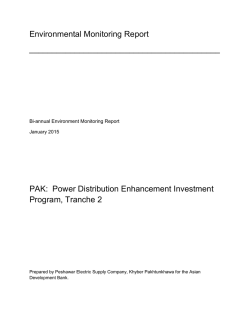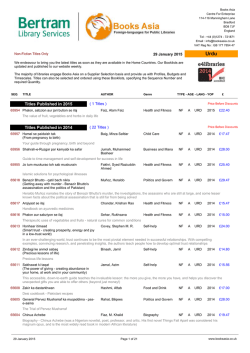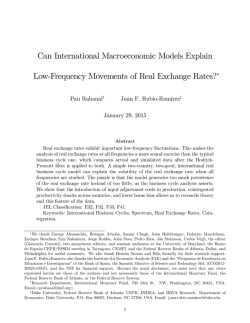
Download (257kB) - Munich Personal RePEc Archive
M PRA Munich Personal RePEc Archive Pakistan Economy: Caught in a Maelstrom Rashid Amjad and Musleh ud Din Economic and Social Commission for Asia and the Pacific 2014 Online at http://mpra.ub.uni-muenchen.de/61668/ MPRA Paper No. 61668, posted 30. January 2015 01:24 UTC Pakistan Economy: Caught in a Maelstrom Rashid Amjad* and Musleh ud Din** Starting in the second half of 2007, the Pakistan economy began to show distinct signs of slowing down and started experiencing serious pressures on its fiscal and balance of payments situation. Growth in the economy took a sharp downward turn. By early 2012 the economy still had not recovered and remained mired in deep stagflation – characterised by low growth and high inflation. Economic policies that were adopted, including the ones under an International Monetary Fund (IMF) programme since November 2008, appear to have been of little help in reversing this situation. Why Pakistan’s economy has not been able to break out of stagflation? What fundamental factors have been responsible for this situation? Why has Pakistan been the laggard among the countries in South Asia and the larger Asia-Pacific region, that were able to relatively recover faster from the global financial crisis? What measures are needed to move out of this maelstrom? This chapter attempts to answer these questions. Its fundamental message is that the Pakistan’s economy faces serious structural imbalances which make it very vulnerable to external shocks and are primarily responsible for its stopgo cycles of economic growth (Amjad et al., 2011 and McCartney, 2011). The economic problems the country faces, as we show in this chapter, are basically structural in nature and not just due to cyclical movements in the global economy. Pakistan’s recent economic performance Understanding the dynamics of Pakistan’s economy has never been easy. Time and again the country’s economic performance has proven its critics wrong. With relatively low levels of investments and savings, its growth performance has been reasonably impressive though not spectacular. During 1970-2010, its average rate of growth was a healthy 5 percent, though its growth path has always moved in stop-go cycles. * Vice Chancellor, Pakistan Institute of Development Economics, Islamabad. Joint Director, Pakistan Institute of Development Economics, Islamabad. ** During 2002 to 2007, Pakistan had been witnessing a phase of impressive growth with moderate inflation (Table 6.1). There were no real signs that the economy was about to falter, though there was some unease expressed about the economy’s susceptibility to external shocks (Amjad, 2007). Indeed, official circles were upbeat about the economic performance with claims that Pakistan had finally freed itself from its past heavy reliance on external borrowings and was on a path of achieving self-reliant sustainable growth. It was therefore somewhat of a rude surprise when the Pakistan economy suddenly plunged into a deep economic crisis in 2007-2008. Table 6.1. Pakistan’s Economic Performance FY 2001 to FY 2011 2001 2002 2003 2004 2005 2006 2007 2008 2009 2010 2011 GDP Growth (%) 2.0 3.1 4.7 7.5 9.0 5.8 6.8 3.7 1.7 3.8 2.4 Fiscal Deficit (% of GDP) 4.3 4.3 3.7 -2.3 -3.3 -4.3 -4.4 -7.6 -5.3 -6.3 -4.7 Current Account Deficit (% of GDP) 1.8 0.4 0.5 1.2 -4.0 -6.5 -6.6 -9.0 -7.8 -6.5 0.4 Inflation (%) 3.1 3.3 2.9 4.6 9.3 7.9 7.8 12.0 20.8 11.5 14.1 Source: Pakistan Economic Surveys and State Bank of Pakistan, Quarterly Reports, various issues. What is perhaps not well-known is that Pakistan’s economy faltered not with the onset of the global financial crisis (GFC) in the second half of 2008 but before that, when the economy was hit by an unprecedented increase in global oil and food prices in 20072008. This shock forced policy makers to adopt contractionary policies to stabilise the economy. These measures were reflected in the budget adopted in June 2008 for 20082009. Though not officially acknowledged, the agreement appeared to have been reached with the IMF for support, even though the IMF programme was signed later that year in November 2008. The basic question then is not just about the impact of the global recession on the economy of Pakistan. Equally, and perhaps more important, is the vulnerability of the economy to the oil and commodity price shock that preceded the global recession. It is then quite pertinent to ask whether Pakistan’s economy would have actually fared not too differently from its other South Asian neighbours in terms of deflecting (and subsequently recovering faster from) the GFC in the absence of the oil and commodity price shock. To try and answer this question we start by examining Pakistan’s economic performance post-2000 in terms of economic growth and the movement of key macroeconomic indicators (Table 6.1). The turnaround in Pakistan’s economy post-2003 was preceded by a sharp compression as the new Musharraf government entered into an IMF agreement in 1999 in the face of a possible debt default and very high fiscal deficits. Pakistan’s economy in the 1990s had not performed well as successive democratic governments were unable to push through the needed reforms and successfully complete any of the IMF support programmes they had entered into. The nuclear explosion in May 1998 had also led to a sharp decline in donor assistance. This situation was worsened by the impact of the Asian financial crisis (AFC). The Musharraf government used the period under the IMF programme to bring in a number of important reforms covering the financial sector, monetary management, and taxation reforms. The economy rebounded as business confidence increased with Gross Domestic Product (GDP) growth climbing to 9 percent in 2004-05 from just 2 percent in 2000-2001.Total investment at around 20 percent of GDP in 2004-05 also became more respectable, though domestic savings continued to remain low (around 8-10 percent of GDP) with the gap being made up by foreign savings. The growth momentum, however could not be sustained as the very forces that had helped propel the economy post-2001 were also in many ways responsible for bringing to an end the boom which peaked in 2004-05. Cheap money supply led to a monetary overhang (Janjua, 2005) that fuelled inflation and the rise in oil prices stoked inflation further. In the face of rising inflation and increasing oil imports (cheap credit had led to large increases in sales of energy–intensive products like automobiles, motorcycles, air-conditioners etc.) the government began to put brakes by raising interest rates and reducing the money supply. The unprecedented increase in global oil and food prices that followed in 2007 put the Musharraf government in a quandary as macroeconomic imbalances started to build up and economic activity took a sharp hit in a context of rising political instability. By March 2008, when the new government took office, the economy had slid into a full blown crisis with ballooning fiscal and current account deficits, sharply rising inflation, and dwindling foreign exchange reserves, which were fast depleting by almost US$1 billion a month with total reserves at around US$16 billion. With the economic situation fast deteriorating, the new government was left with no option but to seek the support of the IMF and signed a Stand-By-Arrangement in November 2008. The key elements of the stabilisation programme were a reduction in fiscal deficit including through cuts in public spending, a tight monetary policy with a 200 basis point increase in interest rates to 15 percent, and a flexible exchange rate regime which resulted in a twenty-five percent depreciation of the rupee vis-à-vis the US dollar. But in spite of these stabilisation efforts Pakistan was not able to lift itself out of stagflation due to a combination of factors, including policy slippages, the most notable being the lack of coordination between fiscal and monetary policies, the inability to introduce key structural reforms including the nonimplementation of the reformed General Sales Tax (GST), security problems, and crippling energy shortages. Impact of the global recession and policy responses The GFC came at a time when the economy was already under stress due to the terms of trade shock resulting from the global food and fuel price hikes. The GFC amplified Pakistan’s economic difficulties with a marked slowdown in economic growth coupled with a sharp rise in the current account and fiscal deficits, a spike in inflation, the depletion of foreign exchange reserves, and pressure on the domestic currency. As a result, economic growth witnessed a sharp downturn from an average of 7.3 percent during 2004-07 to 3.7 percent in 2008, further slowing down to 1.7 percent in 2009 as private investment took a hit on heightened security concerns. With the external accounts already under strain, Pakistan experienced a deterioration in the current account balance, which widened to 9 percent of GDP in 2008 and put pressure on the domestic currency. This was accompanied by a sharp rise in the fiscal deficit from 4.4 percent of GDP in 2007 to 7.6 percent of GDP in 2008, as public revenues dwindled with a slowdown in economic growth. In an effort to curtail the fiscal deficit and being unable to cut sticky current expenditures, the brunt fell on the public sector development programme, which fell from nearly 5 percent of GDP to less than 2 percent – with adverse consequences for long term competitiveness and productivity. High fiscal deficits financed through borrowings from the State Bank, coupled with a tight monetary policy, led to crowding out of private investment in a high interest rate environment. Due mainly to a lack of coordination between fiscal and monetary policies, the tight monetary policy failed to curb inflationary pressures in the economy, and the inflation touched an all-time high of 20 percent in September 2008. Though it fell subsequently to nearly 12 percent, it remained in double digit until the second half of 2012. Pakistan’s policy response to the crisis was largely dictated by the IMF programme, under which Pakistan was committed to adopt tight monetary and fiscal policies to restore macroeconomic stability. In response to sharply rising inflation, the monetary policy was considerably tightened, which hurt private investment though its impact on inflation remained muted as the latter was driven as much by supply bottlenecks as by demand pressures due to heavy government borrowing. The IMF agreement also required a sharp reduction in fiscal deficits from 7.4 percent of GDP in 2008-2009 to 4.2 percent in 2009-2010 and further to 3.3 percent in 2010-2011. The tight fiscal and monetary policies dictated by the IMF left little space for macroeconomic adjustments needed to revive the process of economic growth. Key findings Based on the foregoing discussion, three key findings emerge. First Pakistan’s economy was vulnerable to external economic shocks due to its initial conditions, including macroeconomic and structural imbalances that acted as shock amplifiers. Second, despite contractionary policies prescribed under the IMF programme, Pakistan failed to address macroeconomic imbalances due mainly to poor macroeconomic management. Third, the impact of the financial crisis was considerably mitigated due mainly to some shock absorbers in the economy, including a sound financial system, reliance on consumption rather than exports, and a healthy inflow of remittances. Pakistan’s vulnerability to external economic shocks stemmed from a high concentration of exports in cotton and textiles, heavy reliance on external financing, high current account deficits coupled with a de facto open capital account, low foreign exchange reserves and a weakening domestic currency. All these factors combined to make Pakistan especially prone to cuts in external financing and a slack in global demand for cotton and textiles products. Though Pakistan’s macroeconomic policy response was constrained by the IMF programme, poor economic management was largely responsible for the failure to correct macroeconomic imbalances, which continued to pose a risk to the revival of economic growth. First, overdependence on monetary policy to contain the inflationary pressures was a mistake. While a tight monetary policy stance failed to curb inflation, it hurt the growth process by stifling private investment on the back of high interest rates. Inflation remained stubborn as it was driven by high fiscal deficits and supply bottlenecks, including unprecedented power shortages that crippled economic activity. Second, the fiscal policy response was insufficient, especially revenue generation, and mainly resulted in cuts in development expenditure that were critical to sustain economic growth. Given Pakistan’s adverse initial conditions, the impact of the crisis would have been much greater had it not been for some shock absorbers that helped contain the fallout from the crisis. First, a sound financial system that was largely insulated from global financial upheavals helped limit the transmission of financial shocks to the domestic economy. Second, Pakistan’s reliance on domestic consumption rather than exports provided a cushion to the domestic economy against a slump in demand in the west. Third, Pakistan continued to receive healthy inflow of remittances that provided a critical support to its balance of payments. The above discussion also helps to explain why Pakistan was unable to deflect the crisis, as was done by its South Asian neighbours – most notably India and Bangladesh. The initial conditions in both India and Bangladesh were much healthier than in Pakistan. The macroeconomic situation in both the countries was characterised by robust growth, low fiscal deficits, low inflation, and comfortable current account and reserves positions. The strong macroeconomic fundamentals not only enabled these economies to withstand the external shocks but also provided them the necessary policy space to counter the potential adverse impacts of the crisis. Concluding remarks The most pressing challenge facing Pakistan today is to break out of the current prolonged spell of stagflation. At the same time, there is a need to reduce vulnerability to emerging pressures on the balance of payments, especially when the global economic outlook continues to be uncertain with the United States (US) still in a phase of slow recovery and the euro zone taking a hit on account of the debt crisis of some of its members. Pakistan has endured a series of supply shocks resulting from consecutive floods, unprecedented energy shortages, and a difficult domestic security situation. Consequently, economic growth remains below potential and is unlikely to pick up unless reforms are undertaken to remove supply side bottlenecks, especially the alleviation of energy shortages. Recent research (Malik, 2012) has shown that the roots of the energy crisis lie in poor governance, indicating that the problem can be mitigated to a significant extent by bringing about improved economic management in the energy sector. Pakistan needs to grow at 7-8 percent per annum to provide employment opportunities to its growing labour force, and this is possible only if structural reforms are undertaken to put the economy on a higher growth trajectory on a sustained basis (Planning Commission, 2011). Tackling inflation is another important challenge. Although inflation has moderated in the recent period, inflationary pressures persist, especially at a time when domestic oil prices have increased and domestic currency has weakened considerably. On the external front, with weakening exports, Pakistan’s balance of payments have come under pressures which are likely to intensify as loan repayments to the IMF become due. Worse still, the global economic outlook does not present a very optimistic scenario as the US is still struggling to recover while the euro zone is mired in a fast spreading debt crisis that threatens the very survival of the euro itself. In this scenario, deft macroeconomic management would be required to protect the economy from adverse external shocks. To move the Pakistan economy out of the maelstrom requires a three-pronged strategy focussed on macroeconomic management, structural reforms, and drivers of economic growth. First, prudent macroeconomic management is essential to put the economy on the path of sustainable growth. There is an urgent need for a better coordination between fiscal and monetary policies to restore macroeconomic balance and secure price stability. Though government borrowing from the central bank has been curtailed in recent months, the government has resorted to borrowing from the commercial banks that are accompanied by massive liquidity injections by the central bank. This practice tends to crowd out private investment while making it difficult for the monetary policy to control the rate of inflation. Also, there is a need to carefully calibrate monetary policy to balance the objectives of price stability and economic growth. Second, Pakistan has been unable to implement key structural reforms due mainly to a lack of political consensus. There is, therefore, an urgent need to develop a consensus on reforms paving the way for the implementation of much needed reforms in all segments of the economy especially resource mobilisation, restructuring of the stateowned enterprises, and the energy sector. In particular, the inability of the government to raise sufficient revenues has been the root cause of Pakistan’s economic troubles and there is thus an urgent need for reforms in the taxation system including the introduction of Reformed GST, removal of poorly targeted subsidies, and restructuring of the stateowned enterprises to curtail their huge losses. Third, there is a need to undertake critical public investments particularly in infrastructure, energy, and human resource development which are important drivers of economic growth. The fact that the public sector development programme has been curtailed in recent years in efforts to restore fiscal discipline does not augur well for the country’s long term competitiveness. There is a need to channel public spending towards more productive expenditures to foster productivity growth on a sustained basis. References Amjad, R. (2007). “The Musharraf development strategy: will it deliver?” Lahore Journal of Policy Studies, Vol. 1, No. 1. Amjad, R., and others (2011). Pakistan: breaking out of stagflation into sustained growth. The Lahore Journal of Economics, Vol. 16, pp. 13-30. Janjua, M.A. (2005). Money supply, inflation and economic growth: issues in monetary management in Pakistan. The Lahore Journal of Economics, Special Edition, pp. 73-105. Malik, Afia (2012). Power Crisis in Pakistan: A Crisis of Governance?, PIDE Monograph Series. Islamabad: Pakistan Institute of Development Economics. Available from www.pide.org.pk/pdf/publications/Monograph/Monograph-4Afia%20Malik.pdf. McCartney, M. (2011). Pakistan – The Political Economy of Growth, Stagnation and the State: 1951-2008, London, Routledge. Pakistan, Planning Commission (2011). Pakistan: Framework for economic growth. Islamabad, Pakistan: Author. Pakistan, Planning Commission (2008). Economic stabilization with a human face. Interim Report of the Advisory Panel of Economists. Islamabad, October.
© Copyright 2025
